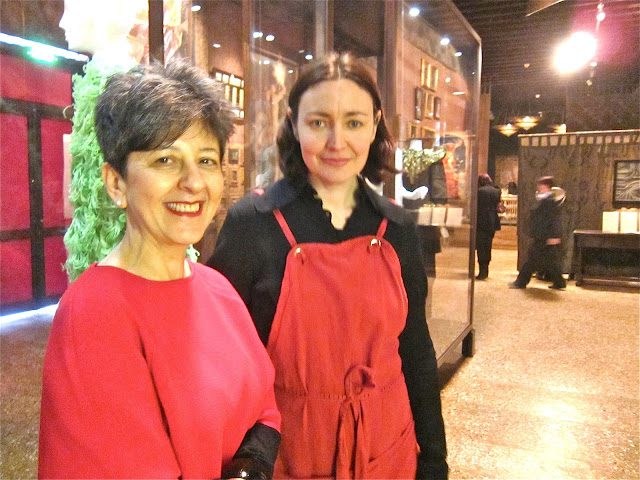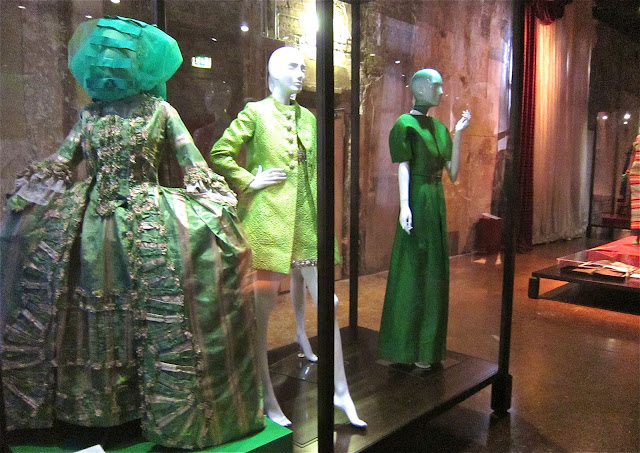Diana Vreeland and Andy Warhol in Piazza San Marco in Venice, Summer 1973. from the book by Eleanor Dwight, Diana Vreeland, New York, Harper Collins, 2002.
“Nothing is more marvelous than sitting at a little table in the gathering of dusk in the Piazza san Marco, the guest of six golden-bronze horses prancing away to paradise”. DV*
Palazzo Fortuny: Diana Vreelend After Diana Vreeland exhibition. At Palazzo Fortuny, until June 25, Diana Vreeland After Diana Vreeland exhibition curated by Maria Luisa Frisa and Judith Clark, was commissioned by Lisa Immordino Vreeland and coordinated by Daniela Ferretti. It is the first major exhibition to be dedicated to the extraordinary and complex Diana Vreeland (Paris 1903- New York 1989). It explores the many sides of her work and seeks to offer a fresh approach with which to interpret the elements of her style and thinking. The aim being to restore the sense of the "magnificent gait" with which the "High Priestess of Fashion", as she was also known, processed through fashion of the twentieth century, initially during her years at Harper's Bazaar and Vogue, and then in her role as Special Consultant for the Costume Institute at the Metropolitan Museum of Art in New York.
Note: all DV Diana Vreeland quotes are taken from the catalogue Diana Vreeland After Diana Vreeland by Judith Clark and Maria Luisa Frisa and published by Marsilio.
DV. The cabinet for Black and White is indebted to her
double-page compositions and so the vertical structure of the cabinet uses a
different set of rules: the cabinet frame becomes graphic lines across a page.
The cabinet with its reference to fashion spreads disrupts the museum cabinet
just as she disrupted the rules of museum practice with the rules of fashion.
DV. Black and white
- Africa -
DV’s mother’s hunting
trips
- zebra -
Le Chant du Rossgnil -
DV’s zebra bangles -
the black
and white of the Belle Époque - ceremony
- mourning -
black Balenciaga...
Above: Henri Matisse costume for the Ballets Russes.
“I don’t think anybody has been in a better place at a better time than I
was when I was editor of Vogue. Vogue
always did stand for people’s lives. I
mean, a new dress doesn’t get you anywhere: it’s the life you’re living in the
dress, and the sort of life you had lived before, and what you will do in it
later. Like all great times, the sixties
were about personalities. It was the
first time when mannequins became
personalities. It was a time of great
goals, an inventive time… and these
girls invented themselves. Naturally, as an editor I was there to help
them along.” DV.
photograph Francesco de Luca courtesy Fortuny Press office
"The Ballets Russes, which is the only avant-garde I’ve ever known..". DV
Leon Baskt costume of a bayadere for Diaghilev’s Le
Dieu Bleu, 1912 and Valentino Haute Counture, fall/winter 1981-1982 designed
for Diana Vreeland.
Rene Bouche, portrait of Diana Vreeland, 1963ca.
Cecil Beaton, sketch of Diana Vreeland, gifted to her
in 1963
Cristian Berard, Sketch of Diana Vreeland, 1941
DV. Curators of the Diana Vreeland After Diana Vreeland exhibition, Maria Luisa Frisa and Judith Clark.
There is always a green room in Vreeland's exhibitions.
“Why don’t you? Have a room done up in every color
green? This will take months, years, to collect, but it will be delightful—a
melange of plants, green glass, green porcelains, and furniture covered in sad
greens, gay greens, clear, faded, and poison greens? And object across time
where color coded
18th century and her coining of the phrase Palazzo Pyjama and
her love of YSl are brought together because they are green, different greens.
She privileged qualities of the object that may not be privileged today—the
color over the 18th century?” DV.
 DV. 1909-1939 or The 10s, The 20s and The 30s. Couture
from those years was the subject of Vreeland’s exhibition but also represented
for her a quintessential glamor and luxury. Chanel, Fortuny, and Schiaparelli.
Her past and her preferences permeate all her exhibitions.
DV. 1909-1939 or The 10s, The 20s and The 30s. Couture
from those years was the subject of Vreeland’s exhibition but also represented
for her a quintessential glamor and luxury. Chanel, Fortuny, and Schiaparelli.
Her past and her preferences permeate all her exhibitions.
DV. Lisa Immordino Vreeland, who commissioned the exhibition and her husband Alexander Vreeland, Diana's grandson.
photograph Francesco de Luca courtesy Fortuny Press office
A cabinet with personal memorabilia and photographs, letters, books, sketches and above a row of DV's shoes.
What Becomes a Legend Most? An advertisment for Blackglama mink.
architects Joffrey and Kate Weaver
DV.
This tableau was one of the first that made a
connection between dress and the art world explicitly, not so much by
juxtaposing the dress with the Mondrian “original” on the wall, but by
exhibiting it flat, on the wall—by treating it as art. It is about
exhibition-making but she didn’t call it that. By hanging a dress flat you are
creating a different set of associations. Captions cannot do that work for us;
she knew this intuitively.
Above: The permanent art installation is by Kounalis.
Martin Kamer, Maria Luisa Frisa, Gabriella Belli, Judith Clark and Franca Coin
Luca and Judy Missoni
photograph Francesco de Luca courtesy Fortuny Press office
One of Vreeland's many orientalisms
DV. Center,
North Africa tableaux and on the left; Japonisme and Chinoiserie are
irreverently combined— they recall two distinct exhibitions (Diaghilev: Costumes
& Designs of The Ballets Russes, December 20, 1978-April 15, 1979; The
Manchu Dragon: Costumes of China—The Ch’ing Dinasty, December 16,
1980-August 30, 1981; La Belle Époque, December 6, 1982-September 4,
1983), but combined in her pages of Vogue as something fascinating and
remote but not specifically historical.
Barbara and Antonio Foscari, Adalberto Cremonesi and Carolina Valmarana
DV. Italy/Props. Diana Vreeland believed that all stories were dramatic.
Her exhibitions at the Met had at the entrance a pointof view, a vista, a prop! Usually a huge prop, here re-
created by a horse. It is surrounded by three mannequins
dressed in Pucci and Missoni, the Italian fashion houses
she championed in America and whose color and
glamour she so loved. The horse is no longer the 17th
century white horse that she used in her first show, The World of Balenciaga, but its Italian counterpart that
welcomes the visitor to Italy instead. Italy becomes our
focal point, our point of view.
Rosita Missoni stands between two of her designs.
Amerigo Restucci, rector Universita Iuav di Venezia behind him, armor, copy of an original from XVI century and a cape by Biki in red silk taffeta late 60's early 70s.
DV. Acclaimed fashion hair stylist Angelo Seminara (above) designed wigs that link the worlds of fashion styling and of museum staging, seeing “historic” wigs through contemporary eyes. The 18th century wig created by Harold Koda when he was an assistant to Vreeland is as iconic in its way as the clothes she exhibited.
Beppe Modenese, Barbara Berlingieri and Piero Pinto
DV. Dalziel Curtains. “Why don’t you, if you have a dark-dining room in a city apartment, stop trying to brighten it and paint in dark grape red and drape the windows in festoons of real Scotch tartan?” DV.
DV. Vreeland was proud of her Scottish ancestry.The Dalziels had not lived in Scotland for many
generations but she loves their family motto: “I dare.” She wrote in her teenage diary: “I am Diana, a goddess,
therefore ought to be wonderful, pure, marvelous, as
only I alone can make myself... no one can ever rob me
of that name, never shall I change it. Diana was a goddess and I must live up to that
name, Dalziel = I dare, therefore I dare, I dare
change to day, and make myself exactly
how I want to be.” DV.
Rosella Mamoli Zorzi, Liselotte Hohs and Rosita Missoni
Palazzo Fortuny
Couture collector, Cecilia Matteucci Lavarini lent eleven garments for the exhibtion, she is wearing a Balenciaga coat.
DV. “September 16, 1968 – Re: SERPENTS – Don’t forget
the serpent… - The serpent should be on evey finger and all wrists and all
everywhere… - The serpent is the motif of the hours in jewelry… - We cannot see enough of the…” DV.
A gilded bronze and coral Cameo, once owned by Yves Saint Laurent is worn as a pendent by Cecilia Matteucci Lavarini.
Riccardo Priolisi, Tord Dyrssen and John Hooks
Jewelry designer and sculpture Giorgio Vigna
DV. From the pages of Vogue Mel Ferrer filming "The Brave Bulls" in Mexico.
Paolo Baratella, Giorgia Voltan and Massimo Varetto
Director, stage director, and costume designer Pier Luigi Pizzi
Diana Vreeland









































